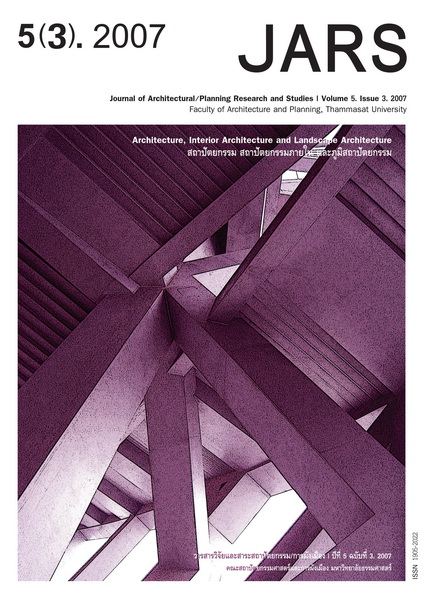The Democracy Monument: Ideology, Identity, and Power Manifested in Built Forms
Main Article Content
Abstract
This research article examines the methods of power mediation in the design of the Democracy
Monument in Bangkok, Thailand. It examines its underlying concept and mechanisms for conveying political
power and social practice, along with the national and cultural identity that operates under an ideological
framework. The study consists of two major parts. First, it investigates the monument as a political form of
architecture: a symbolic device for the state to manifest, legitimize, and maintain power. The focus then
shifts to an architectural form of politics: the ways in which ordinary citizens re-appropriated the Democracy
Monument through semantic subversions to perform their social and political activities as well as to form
their modern identities. Via the discourse theory, the analytical and critical discussions further reveal
complexity, incongruity, and contradiction of meanings in the design of the monument in addition to
paradoxical relationships with its setting, Rajadamnoen Avenue, which resulted from changes in the country’s
socio-political situations.
Downloads
Article Details

This work is licensed under a Creative Commons Attribution-NonCommercial-NoDerivatives 4.0 International License.
All material is licensed under the terms of the Creative Commons Attribution 4.0 International (CC-BY-NC-ND 4.0) License, unless otherwise stated. As such, authors are free to share, copy, and redistribute the material in any medium or format. The authors must give appropriate credit, provide a link to the license, and indicate if changes were made. The authors may do so in any reasonable manner, but not in any way that suggests the licensor endorses you or your use. The authors may not use the material for commercial purposes. If the authors remix, transform, or build upon the material, they may not distribute the modified material, unless permission is obtained from JARS. Final, accepted versions of the paper may be posted on third party repositories, provided appropriate acknowledgement to the original source is clearly noted.
References
Saussure, de F., Charles, B., Albert, S., Albert R., & Wade B. (1966). Course in general linguistics. New York: McGraw-Hill Book.
Goodman, N. (1968). Languages of art: An approach to a theory of symbols. Indianapolis, IN: BobbsMerrill.
Foucault, M. (1972). The archaeology of knowledge. New York: Pantheon.
Dovey, K. (1999). Framing places: Mediating power in built forms. London: Routledge.
Winichakul, T. (1994). Siam mapped: A history of the geo-body of a nation. Honolulu, HI: University of Hawaii Press.
Bentley, I. (1999). Urban transformations: Power, people, and urban design. London: Routledge.
Kessing, R. (1989). Creating the past: Custom and identity in the contemporary pacific. Contemporary Pacific, 1(1&2), 19-42.
Ministry of Propaganda. (1936). คู่มือพลเมือง [Handbooks for citizens]. Bangkok, Thailand: Aksonnit.
Ministry of Propaganda. (1942). Prime Minister Plaek Pibulsonggram’s speech on the National Day anniversary, June 24, 1942. Khao Kosanakarn, 5(7).
National Archives no. 0701.22.1/7. (1942). Prime Minister Plaek Pibulsonggram’s speech on the National Day anniversary, June 24, 1942. Bangkok, Thailand.
Nuan la-or, M. (1997). การเมองไทยในย ื คส ุ ญล ั กษณ ั ไทย ์ [Thai polotic in the state symbolic era] (Prime Minister Democracy Monument). Bangkok, Thailand: Ruangreaungrat Printing.
Ministry of Propaganda. (1940). The inauguration of the Democracy Monument. Bangkok, Thailand: GPO.
Hattakijkoson, P. (1983). Thai monuments: A political study. Graduate Thesis, Chulalongkorn University, Bangkok, Thailand.
Wikipedia. (2007). Democracy Monument, Bangkok. Retrieved January 31, from http://en.wikipedia.org/wiki/Democracy_Monument.
Dovey, K. (2001). Memory, democracy and urban space: Bangkok’s path to Democracy. Journal of Urban Design, 6(3), 265-282.
Wong, K. F. (2006). Visions of a nation: Public monuments in twentieth-century Thailand. Bangkok, Thailand: White Lotus.
Pramoj, K., M.R. (1999). สี่แผ่นดิน [Four reigns] (Tulachandra, Trans.). Bangkok, Thailand: Silkworm.
Rojpojchanarat, V. (1987). The conservation of monuments in Thailand (Final report of communitybased conservation and maintenance on historic buildings/living monuments, August 23-30). Bangkok, Thailand: SEAMEO Regional Center for Archaeology and Fine Arts.
Human Rights Watch. (1992). Human rights development in Thailand. Retrieved January 27, 2007, from http:// www.hrw.org/reports/1993/WR93/Asw-11.htm#P397_166328
Aasen, C. (1998). Architecture of Siam: A cultural history interpretation. New York: Oxford University Press.
Eoseewong, N. (1995). ชาตไทย ิ เมองไทย ื แบบเรยน ี และอนสาวร ุ ยี ์ [Thai nation, Thailand, school texts, and monuments]. Bangkok, Thailand: Matichon.
Tejapira, K. (1996). Signification of democracy. Thammasat Review, 1(1), 5-13.
Prakitnondhakarn, C. (2004). การเมืองและสังคมในศิลปสถาปัตยกรรม: สยามสมัย ไทยประยุกต์ ชาตินิยม [Political and social factors in Thai art and architecture]. Bangkok, Thailand: Matichon.


